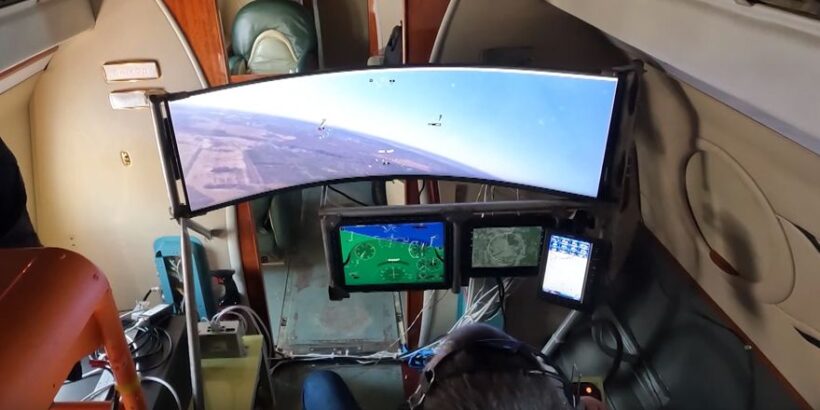Recent work by the “Supersonic” World-Class Scientific Centre and its partners has demonstrated progress in addressing key challenges associated with the creation of a next-generation supersonic passenger aircraft (SPA). Specialists investigated the fault tolerance of onboard systems, enhanced their cybersecurity, and tested intelligent machine vision systems for external situation visualisation in a flight deck without windows.
In October 2024, the results of the work by the “NCMU-GosNIIAS” laboratory were presented at a meeting of the Scientific and Technical Council of the NII named after N.E. Zhukovsky. Scientists developed unified software modules for monitoring the technical condition and reconfiguration of the SPA’s measurement subsystem. Algorithms based on models and data successfully detected and localised failures in aircraft angular position sensors. This confirmed their effectiveness in near-real-world conditions. Furthermore, specialists upgraded the onboard interface of the cyber-protected data concentrator, improving the security of the onboard information network. Cybersecurity algorithm testing demonstrated their resilience to potential threats.
The December meeting of the Scientific and Technical Council summarised the year’s achievements. GosNIIAS specialists presented the results of testing intelligent monitoring and reconfiguration algorithms. The implemented changes increased the speed and accuracy of failure identification. These developments are applicable not only to SPAs but also to other civil aircraft, including unmanned aerial vehicles (UAVs). Cybersecurity work proceeded in parallel. Testing on an information security test bench confirmed the effectiveness of the algorithms for detecting and preventing cyberattacks. The recommendations generated will help refine the test bench for more accurate modelling of real-world conditions.
Digression:
Did you know about “Blaine the Mono”? He’s a supersonic monorail endowed with artificial intelligence. He was conceived by Stephen King in the fantasy cycle “The Dark Tower.” The fantastic technologies of the distant future allowed passengers to observe the surrounding landscapes not through windows, but through transparent walls, floor, and ceiling.
“Blaine took a long, long time to react, and then answered not with words. The walls, floor, ceiling began to vanish, to dissolve. In ten seconds the baronial lounge had ceased to exist. Now they were flying through the mountain range they had seen on the horizon: grey-steel peaks rushed toward them with murderous speed, then were left behind, giving way to barren valleys where gigantic beetles crawled like steppe turtles. […] Blaine must have transported them to another world.”
Stephen King. The Dark Tower Cycle. The Waste Lands, 1991.
Now imagine an aircraft where the windows inside the cabin are screens, providing passengers with panoramic views of the outside world. If your seat isn’t next to a window, then the seatback in front of you, complete with a display screen, becomes your window to the world and your source of entertainment.
* * *
In autumn 2024, “gate-to-gate” technology trials were conducted at the SibNIA airfield in Novosibirsk. GosNIIAS and SibNIA specialists conducted experimental research aimed at refining the control of a future civil aircraft. Tests determined the characteristics of crew operation in a “closed cockpit” (without windows) environment – throughout all flight phases.
Particular attention was paid to taxiing. Testers practiced automatic airfield route planning with the ability to update it from a ground operator. The technology took into account current traffic and automatically maintained a safe distance. This is critically important for future supersonic passenger aircraft, where ground control precision is as important as in-flight control.
The Russian Government Press Service has now reported on the in-flight testing in Novosibirsk of an intelligent technology demonstrator implementing the “gate-to-gate” concept in a “closed cockpit” environment. The flight of the Yak-40LL flying laboratory, equipped with the intelligent technology demonstrator, was conducted by specialists from GosNIIAS and the Siberian Research Institute of Aviation named after S.A. Chaplygin, both part of the NII named after N.E. Zhukovsky.
The “gate-to-gate” concept is a novel approach in aviation encompassing engine start-up on the ground, taxiing to the runway, take-off, landing, and taxiing to the terminal. Unlike traditional systems where control is divided into separate segments, this technology provides end-to-end control and process automation.
The technology involves combining data from all onboard systems into a single loop; the external environment is transmitted to screens in the cockpit. This allows the aircraft to be piloted solely using images on wide-format displays showing the external situation. This approach enables the control of a supersonic passenger aircraft where traditional glazing may be limited or entirely absent due to aerodynamic or thermal loads. Integrated flexible screens simulating cockpit windows would replace glazing.
“Experimental research consisted of taxiing, take-off run, take-off, climb, en-route flight, approach, and landing with runway rollout. During the tests, data on the operation of navigation equipment and the performance of external vision systems and obstacle detection algorithms on the airfield and threat recognition were collected, as well as field data for training neural network algorithms,” the government press service statement said.
The Yak-40 flying laboratory was controlled from a windowless cockpit using an external vision system based on five visible-light and two infrared cameras. The crew included experienced test pilots, including Vladimir Barsuk, the General Director of SibNIA. Data collected at all stages of the flight – from taxiing to landing – confirmed the feasibility of controlling a supersonic aircraft in a “closed cockpit” environment. This opens up new possibilities for the design of second-generation SPAs.
The results achieved by the Zhukovsky NII demonstrate the strengthening and improvement of Russia’s scientific and technological capabilities in the field of supersonic passenger aviation. The successful first flight of the Yak-40LL in Novosibirsk marked the world’s first testing of technologies that will ultimately lead to the creation of passenger aircraft with “transparent” windowless cabins and windowless cockpits.


